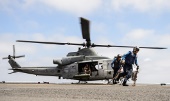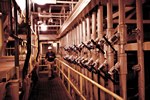
By Jessica Acklen
It's time to talk health and safety in Montreal at the 73rd AIHce event.

By John Astad
Any future combustible dust legislation or regulation must include local, regional, and state governmental participants and an understanding of the breadth of combustible dust-related fires.
By Maureen Butler
Automated safety intelligence-gathering systems are helping industrial hygienists and safety managers work smarter while saving dollars to the company's bottom line.
By Margaret Halasnik, Kelly Clarkson, George Weiss
Asbestos, lead paint, and an approaching hurricane are some of the challenges overcome during a remediation project at a Virginia military base.

By Carolyn Kidd
Military personnel need gear that allows them to perform their duties effectively and efficiently under various environmental conditions, while remaining comfortable and safe.
By Keith Bilger
Many jobs requiring the use of respirators can leave employees mentally and physically drained. Tired employees are more apt to get careless and make mistakes or cut corners.

By Linda J. Sherrard
Do whatever is needed to ensure a clear pathway to the eyewash/shower unit. No stacks of junk, excess storage, or trash bins should interfere.
By Kim Williams
Be detailed -- include the entire product name, manufacturer, product code, container, physical form, and quantities.
By Shawn M. Galloway
Standing outside the pharmacy, what should have been recognized as warning signs became boldly obvious and I felt embarrassment for thinking, just 10 minutes prior, that I felt fine.
By Jerry Laws
"We have always had a one-size-fits-all approach, blanketing a whole area with CPR training, and we assume that will get to everyone," said Dr. Comilla Sasson, M.D., MS, the statement's lead author.
By Robert Pater
Most of us work and live out of control at least to some degree. Yet wherever we’ve worked worldwide, we’ve found everyone seeks to have more control.